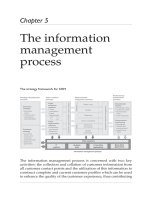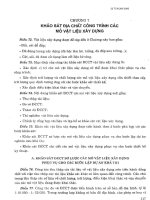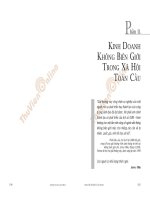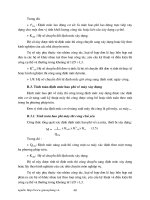Applied C# in Financial Markets phần 5 potx
Bạn đang xem bản rút gọn của tài liệu. Xem và tải ngay bản đầy đủ của tài liệu tại đây (159.92 KB, 13 trang )
P1: KTU/
WY042-03 WU042-Worner July 30, 2004 18:44 Char Count= 0
Object Oriented Programming 33
if (err)
{
throw new TradeException(msg.ToString());
}
}
Example 3.16 shows how the TradeException
is handled on the
form with the exception being caught using the
try and catch
blocks.
Example 3.16: User defined
Exception TradeException being
handled in a block of code
try
{
Trade tr = new Trade(tacct,custacct,qty,price,bs,
symbol,ccy,fx);
}
catch (TradeException except)
{
MessageBox.Show(except.Message);
}
finally
{
// Refresh the grids
pHandler.reloadData("all");
// Clear the input box
clearFields();
}
3.1.3 Workshop: Exercise one
This workshop is the first in a series of workshops that are built on
throughout the book. The idea is that by building on the workshops the
end result is a relevant application; an options calculator was chosen for
its simplicity in terms of building an application. Each workshop takes
the application a step further as well as giving you the chance to put into
practice some of the concepts you have just learnt.
The specification has been written and can be found in Appendix A;
in addition, a diagrammatic representation of the options calculator can
be seen in Appendix B. The actual models implemented in creating the
workshops can be seen in Appendix C, along with details of how to
download the source files.
P1: KTU/
WY042-03 WU042-Worner July 30, 2004 18:44 Char Count= 0
34 Applied C# in Financial Markets
The first part of the workshop is to create a new Windows application
project. By default a Windows form is added to the project. Add the
following components on the form.
Text boxes and labels
Strike price
Stock Price
Volatility
Risk Free rate
Result (set to read-only and use it to display the
price).
DateTime Picker
Expiry Date
Radio buttons
Put and call
Black Scholes and Implicit Finite-Difference
Button
Calculate
These form the input boxes required by the models to return a price.
Further components will be added onto theform as the exercises progress
through the book.
Figure 3.1 Basic options calculation form
P1: KTU/
WY042-03 WU042-Worner July 30, 2004 18:44 Char Count= 0
Object Oriented Programming 35
Create a new class that will encapsulate these input fields called op-
tion. Overload the constructor so that the constructor can take the input
parameters from the form as either text data directly from the form text
boxes or numeric data where the data have already been converted to
numeric data where applicable. Create the input parameters as read-only
properties.
For this exercise create a method called
getMessage which returns a
string.
The final step is to add the event
onclick to the calculate button, and
then in the code block create an option object passing the parameters
collected from the form. Call the
getMessage method putting the output
to a
MessageBox.
Try running the project, entering some values and clicking the cal-
culate button. If it all compiles and runs, the result of clicking the cal-
culate button should be a pop-up message returning the string from
getMessage.
You may have noticed that a system exception occurs if no values are
entered into the text boxes. There should be some validation in place to
trap the errors and inform the users that an error has occurred and what
steps they need to take to correct it.
At the absolute minimum some
try/catch blocks need putting
around the parsing of the text to a numeric field. The better approach
is to perform the numeric parse in the option class and throw an
OptionException
, catching it in the form.
OptionException
is not
a system exception and will need writing.
As we have learnt, an application exception must have the three con-
structors created to handle the various ways. Create a new class and
name it
OptionException; base it around Example 3.14.
In the option class, where the numeric parsing is done, add some
validation. If there are any validation errors then an
OptionException
needs throwing.
In the form class, place a
try/catch block around the option object
to catch the
OptionException and in the catch block alert the user to
the validation error, as shown in Figure 3.2.
3.2 INHERITANCE AND POLYMORPHISM
In C#, as in other Object Oriented languages, the ability to inherit from
other classes and interfaces introduces program reuse from a practical
approach. The methods and properties of one class can be used by other
classes that inherit from it. What this means in applied programming is
P1: KTU/
WY042-03 WU042-Worner July 30, 2004 18:44 Char Count= 0
36 Applied C# in Financial Markets
Figure 3.2 Validation error
that a set of common features are built into a base class and the specific
elements of functionality are built into the inherited class.
There are cases where each of the derived classes will need to have
their own customised method where the base class method is overridden.
This is known as polymorphism.
In the next section the application of inheritance and polymorphism
through base classes and interfaces is explored. An example will be
looked at through design to implementation. Note in C# that it is only
possible to inherit from one base class, otherwise known as single in-
heritance.
3.2.1 Applying inheritance and polymorphism to finance
The best way to understand how inheritance and polymorphism are
applied is to work through an example.
While derivative products have a number of shared attributes and
behaviour there are some features specific to each product.
In the futures and options trading application, the futures and op-
tions products are encapsulated into objects to hold the data needed and
provide methods to incorporate their behaviour.
There are several approaches to this. A class can written for each
product type encapsulating the properties and methods; the downside of
P1: KTU/
WY042-03 WU042-Worner July 30, 2004 18:44 Char Count= 0
Object Oriented Programming 37
this approach is that there are common behaviours and properties that
would be duplicated in each class.
A better way is by using inheritance, and polymorphism. Looking at a
future and an option in detail we can compare the features of each prod-
uct and create a grid of common features and specific properties and be-
haviour. As seen in Table 3.2 there is much in common with the two types
of derivatives and some specific properties unique to the instrument.
In designing the product classes a base class is created to encapsulate
the common properties and methods; the
Future and Option classes
inherit the base class and then are extended to encapsulate the specific
properties of each product.
Futures and options may share many attributes, but they do have some
specific data that are peculiar to the product type. Thus the base class
will have a method to retrieve the common data from the database and
supply a method to load the product specific data required by both the
Future and Option class. This then allows the Futures and Options
classes to implement their specific retrieval, thus exhibiting polymorphic
behaviour.
The
Add to Database
, addToDB, method can be defined in the base
class and written in such a way that it can handle the insertion to the
product tables for both products.
Table 3.3 shows the relationship between the base class and the
Future and Option classes. The base class Derivative contains
the common properties and methods. The
Option and
Future classes
contain their own implementation of the
loadExtrasFromDB method,
which loads product-specific properties from the database.
Table 3.2 Comparison of the properties and behaviour of a Future and an Option
Property/behaviour Future Option
Name x x
Days to expiry x x
Strike price x x
Symbol x x
Underlying price x x
Underlying symbol x x
Delta x x
Contract size x
Put or Call x
US or Euro style x
Volatility x
Add to database x x
Retrieve from database x x
P1: KTU/
WY042-03 WU042-Worner July 30, 2004 18:44 Char Count= 0
38 Applied C# in Financial Markets
Table 3.3 A representation of the base class Derivative and
the classes Option and Future that inherit from them
Derivative
Derivative (string)
Derivative (Hashtable)
Delta
expiryDays
name
strike
symbol
ulPrice
ulSymbol
addToDB (string)
loadDataFromDB ()
loadExtrasFromDB ()
Option Future
Option (string) Future (string)
Option (Hashtable) Future (Hashtable)
loadExtrasFromDB () loadExtrasFromDB ()
Having looked at how to approach the creation of the objects and the
relationship between them we will now examine how it is done in C#.
Declaring the
Derivative class as an abstract class means that the
class cannot be instantiated directly and may only be used as a base
class. Example 3.17 shows how the class is declared abstract.
Example 3.17: Abstract class declaration
public abstract class Derivative
{
}
The next step is to declare a Hashtable to hold the data as shown in
Example 3.18; in a simple class this would be held in a private instance
variable. As this is a base class this variable must be visible in the
inherited classes and is thus declared protected, which means it cannot
be accessed outside the derived class.
Example 3.18: Declaring a protected
Hashtable to make it accessible
in
Option and Future
// Declare private variables
protected Hashtable
derivAttrib = new Hashtable();
P1: KTU/
WY042-03 WU042-Worner July 30, 2004 18:44 Char Count= 0
Object Oriented Programming 39
The method loadExtrasFromDB() is implemented differently in the
Future and Option
classes to accommodate the different attributes of
these products. The ability to implement different functionality in the
same method is known as overriding. The method is declared as virtual,
as illustrated in Example 3.19 to allow overriding. This must be done as
all methods are defaulted to non-virtual and thus may not be overridden.
Example 3.19: Creating a virtual method
protected virtual void loadExtrasFromDB(){}
The constructors and common properties are then created in the base
class
Derivative; this can be seen in Example 3.26 where a full listing
of the
Derivative, Option and Future classes is shown.
Having written the
Derivative class the
Option class must now be
written. The class is declared with the colon followed by
Derivative,
as shown in Example 3.20, meaning that the class inherits from
Derivative.
Example 3.20:
Option inherits from Derivative
public class Option : Derivative
{
}
The next step is writing the constructors for the class Option. Inher-
iting from
Derivative means that it must implement the same con-
structors as
Derivative; note that Derivative did not have a default
constructor. Example 3.21 shows the
Option class declaring the two
constructors, with the base keyword specifying that the base constructor
be called when the object
Option is instantiated.
Example 3.21: Declaring the constructors and specifying that the con-
structor in the base class be used
public Option(string symbol):base(symbol)
{
}
public Option(Hashtable h):base(h)
{
}
The loadExtrasFromDB method is overridden in the Option class,
the override keyword indicating that the method is being overridden,
P1: KTU/
WY042-03 WU042-Worner July 30, 2004 18:44 Char Count= 0
40 Applied C# in Financial Markets
thus displaying polymorphic behaviour. The extra fields are appended
into the
Hashtable that contains the class data.
Example 3.22: Overriding the
loadExtrasFromDB method from the
base class
Derivative
protected override void loadExtrasFromDB()
{
string sql = "select putCall,euroUSType from
tblProduct where pSymbol = ‘" + base.symbol + "’";
DBHandler db = new DBHandler();
DataSet ds = db.dbSelect(sql);
DataRow dr = ds.Tables[0].Rows[0];
derivAttrib.Add("putCall",(dr["putCall"].ToString())
.Substring(0,1). ToLower());
derivAttrib.Add("usEuro",(dr["euroUSType"].ToString
()).Substring(0,1). ToLower());
}
The extra properties that are required for the
Option are added in the
usual way of declaring properties as shown in Example 3.23.
Example 3.23: Option specific properties
public string putCallType
{ get {return (string)
derivAttrib["putCall"];}}
public string usEuro{ get {return (string)
derivAttrib["usEuro"];}}
The next class to be written is the
Futures class which is similar
in structure to the
Options class as it derives the methods and proper-
ties from the base class
Derivative. The big difference is the proper-
ties implemented and the overridden method
loadExtrasFromDB. The
Future class has the same implementation of the constructors using the
keyword base.
Example 3.24:
Future class derived from Derivative
public class Future : Derivative
{
public Future(string symbol):base(symbol)
{
}
public Future(Hashtable h):base(h)
P1: KTU/
WY042-03 WU042-Worner July 30, 2004 18:44 Char Count= 0
Object Oriented Programming 41
{
}
public string contract
{ get{return
(string)
derivAttrib["contract"];
}}
protected override void loadExtrasFromDB()
{
string sql = "select contractSize from tblProduct
where pSymbol = ‘" + base.symbol + "’";
DBHandler db = new DBHandler();
DataSet ds = db.dbSelect(sql);
Console.Write(sql);
DataRow dr = ds.Tables[0].Rows[0];
derivAttrib.Add("contract",(int)dr["contractSize"]);
}
}
Now both classes are built with the inherited methods and properties
of the
Derivative class. When the
Option and Future objects are
instantiated the properties and methods are available from both the base
class of
Derivative and the derived classes Option and Future. Ex-
ample 3.25 shows the
Option class being instantiated and the properties
used.
Example 3.25:
Option class being instantiated and the properties ref-
erenced
public void setParams(string symbol)
{
symb = symbol;
Option o = new Option(
symb);
T = o.expiryDays;
X = o.strike;
callPut = o.putCallType;
S = o.ulPrice;
}
The full listing of the Derivative, Option and Future classes is
shown in Example 3.26.
P1: KTU/
WY042-03 WU042-Worner July 30, 2004 18:44 Char Count= 0
42 Applied C# in Financial Markets
Example 3.26: The complete source code for the
Derivative, Option
and Future classes
public abstract class Derivative
{
// Declare private variables
protected Hashtable
derivAttrib = new Hashtable();
//
public Derivative(string
symbol)
{
symbol = symbol;
loadDataFromDB();
loadExtrasFromDB();
}
public Derivative(Hashtable hashFields)
{
StringBuilder field = new StringBuilder();
StringBuilder vals = new StringBuilder();
StringBuilder sql = new StringBuilder();
sql.Append("INSERT INTO tblProduct ");
field.Append(" (");
vals.Append(" VALUES (");
ICollection keys = hashFields.Keys;
ICollection values = hashFields.Values;
foreach(string key in keys)
{
field.Append(key);
field.Append(",");
}
field.Remove(field.Length - 1,1); // remove the
last comma
field.Append(")");
foreach(string val in values)
{
vals.Append(val);
vals.Append(",");
}
vals.Remove(vals.Length -1,1); // chop the last
comma
vals.Append(")");
sql.Append(field.ToString());
sql.Append(vals.ToString());
P1: KTU/
WY042-03 WU042-Worner July 30, 2004 18:44 Char Count= 0
Object Oriented Programming 43
addToDB(sql.ToString());
}
public string name
{
get{ return (string) derivAttrib["name"];}
set{ derivAttrib["name"] = value;}
}
public string symbol
{
get{ return (string) derivAttrib["symbol"]; }
set{ derivAttrib["symbol"] = value;
}
}
public string ulSymbol
{
get {return (string) derivAttrib["ul"];}
}
public double delta
{
get {return (double) derivAttrib["delta"];}
}
public double strike
{
get
{return (double) derivAttrib["strike"];}
}
public double expiryDays
{
get {return (double) derivAttrib["expDays"];}
}
public double ulPrice
{
get
{return (double) derivAttrib["ulPrice"];}
}
private void loadDataFromDB(){
string sql = "select underlySymbol,delta,strike,
expiry from tblProduct " + " where pSymbol =‘" +
P1: KTU/
WY042-03 WU042-Worner July 30, 2004 18:44 Char Count= 0
44 Applied C# in Financial Markets
(string) derivAttrib["symbol"] + "’";
DBHandler db = new DBHandler();
DataSet ds = db.dbSelect(sql);
DataRow dr = ds.Tables[0].Rows[0];
DateTime expire = (DateTime)dr["expiry"];
DateTime today = new DateTime();
today = DateTime.Now;
TimeSpan t = expire.Subtract(today);
derivAttrib.Add("ul",(string)dr["underlySymbol"]);
derivAttrib.Add("delta",(double)dr["delta"]);
derivAttrib.Add("strike",(double)dr["strike"]);
derivAttrib.Add("expDays",(double)t.TotalDays);
// get the underlyer information
sql = "select price from tblPrices where pSymbol =
‘" + (string)dr["underlySymbol"] + "’";
ds = db.dbSelect(sql);
if (ds.Tables[0].Rows.Count > 0)
{
dr = ds.Tables[0].Rows[0];
derivAttrib.Add("ulPrice",(double)dr["price"]);
}
else
{
derivAttrib.Add("ulPrice",0.00);
}
}
private void addToDB(string sql)
{
DBHandler db = new DBHandler();
string res = db.dbInsert(sql);
if (res.Length>0)
{
LogError lErr = new LogError(res);
}
}
protected virtual void loadExtrasFromDB(){}
}
public class Option : Derivative
P1: KTU/
WY042-03 WU042-Worner July 30, 2004 18:44 Char Count= 0
Object Oriented Programming 45
{
public Option(string symbol):base(symbol)
{
}
public Option(Hashtable h):base(h)
{
}
public string putCallType{
get {return (string)
deriv
Attrib["putCall"];
}}
public string usEuro
{ get {return (string)
derivAttrib ["usEuro"];
}}
protected override void loadExtrasFromDB()
{
string sql = "select putCall,euroUSType from
tblProduct where pSymbol = ‘" + base.symbol
+ "’";
DBHandler db = new DBHandler();
DataSet ds = db.dbSelect(sql);
DataRow dr = ds.Tables[0].Rows[0];
derivAttrib.Add("putCall",(dr["putCall"].ToString
()).Substring(0,1).ToLower());
derivAttrib.Add("usEuro",(dr["euroUSType"].ToString
()).Substring(0,1).ToLower());
}
}
public class Future : Derivative
{
public Future(string symbol):base(symbol)
{
}
public Future(Hashtable h):base(h)
{
}
public string contract{ get{return
(string)
derivAttrib["contract"];}}
protected override void loadExtrasFromDB()









